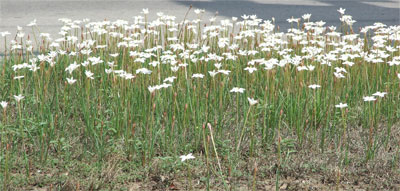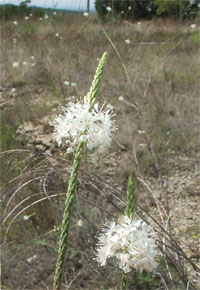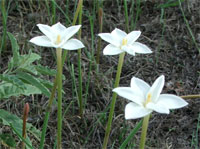Native Son – August, 2008

Rain lilies, Cooperia drummondii, following the recent North Texas deluge. Photo by Steven Chamblee.
It’s About Time
It all started just a few months back, when my neighbor dropped a book in my lap —Einstein’s Dreams, by Alan Lightman. It claims to be a novel, but in reality is a string of thought-provoking short essays centered around Albert Einstein’s theories and musings on time and the impact it has on people’s perceptions of reality. Great brain food for dreamers like me, no doubt.

False gaura, Stenosiphon linifolium. Photo by Steven Chamblee.
Plants are great time-keepers as well. Each year, as that second week of July passes by and I finally give myself permission to complain ad nauseum about the heat, something triggers the false gaura into bloom. Screaming hot temperatures, not a drop of rain for weeks/months, cracks in the ground wide enough to swallow a chihuahua … and this wildflower rises up on the skinniest of stems, branches maybe once or twice, and throws out those pointy flower clusters on the very tips, creating an ever-swaying, 6- to 8-foot tall, wiry sculpture that has had me asking myself for over a decade, “What is that thing?”
A member of Onagraceae, the primrose family, false gaura is a native, short-lived perennial technically known as Stenosiphon linifolium, which roughly translates to “slender tube with flax-like leaves.” Personally, I like the botanical name okay, but kind of resent the “false” part of the common name … like it was trying to sneak into the Gaura genus and got caught. The poor plant just is what it is. I’ll bet people would respect it more if we called it “summer whiterocket.” (Well … I like it.)
So our emotional cries for rain were finally heard by Mother Nature. (I’m told she was vacationing at Butchart Gardens up there in Victoria, British Columbia, and forgot all about us until ol’ Finfrock texted her on the cell phone.… Thanks, Dave!!!)* So she attempted to relieve her guilt by drenching us with buckets of the good stuff. It worked for me. Five and three-quarters inches of earth juice over here in Weatherford just changed my life … and sent another Texas wildflower into instant action.

Rain lilies, Cooperia drummondii. Photo by Steven Chamblee.
The rain had barely stopped when rain lilies popped up all over the place … beside roads, in yards, and even a few in Chandor Gardens. Botanically known as Cooperia drummondii, these little white gems come from bulbs lying a few inches down in the soil, just waiting for a little moisture to trigger them into action. They don’t last very long, which I suppose is a good thing, as the same rain that inspired them to bloom will also inspire the grass to grow an inch or two, which, in turn, will inspire men with giant mowers to action as well. (I could not help noticing the word “obtuse” being used in The BRIT Book to describe the lobes on the flowers. Great word, but it can get you in trouble, as in The Shawshank Redemption. Be forewarned….)
Seemingly unrelated, I got a call from Mark Schusler, my old professor up at Tarrant County College, the other day, which led to me teaching some night classes in horticulture this semester. (“Welcome Back, Kotter,” I know.) This is the best of life for me, for I always learn a great deal while I’m immersed in an academic environment. Which brings me to the point … what really causes dormant rain lilies to be triggered into action? Truth is, I don’t know. One quick telephone call later, and I’m proud to report that nobody actually knows for sure. Could be barometric pressure, could be a certain threshold combination of moisture, temperature, and plant maturity … no one knows. The consumer result is that since it’s difficult to market a plant you can’t predict or coax into flowering, you might not find it in a nursery. Some work has been done with smoke water (yes, water infused with smoke!) with the theory that fire has an influence on the flowering of certain species. This seems to make some sense, as the rain lily populations I’ve observed are definitely densest where the grass has been mowed or burned off. Chemical stimulation, or simple removal of plant competition? Time will tell, I suppose.
All of this reminds my logical self that my curiosity (obsession?) with and about life and time and why’s? extends back into my childhood, when a classmate of mine died in junior high. (Yes, Vince, I remember you.) I guess I realized back then that life is short and there’s no ironclad guarantee that I’ll ever see daffodils or rain lilies again. I don’t know about you, but that thought sure inspires me to collect lots of hugs, use my good Mexican talavera plates daily, sing to my little dog during her tummy rub time, and get out into the garden every day. Hmmm … rain lilies in the lawn. Looks like I’ll have to put off mowing for another week.
* EDITOR’S NOTE: David Finfrock is a meteorologist with KXAS-TV in the Dallas/Fort Worth area.
About the author: Steven Chamblee is the chief horticulturist for Chandor Gardens in Weatherford and a regular contributor to Neil Sperry’s GARDENS magazine and e-gardens newsletter. He adds this invitation to e-gardens readers:
Come see Chandor Gardens this fall! The new Labyrinth is completed and ready for you to enjoy. We’re even having a Scarecrow Contest just for fun. Oct. 25 to Nov. 16, we’ll have a great collection of scarecrows around the garden. This a perfect time for family and children’s photos, so plan on bringing the whole gang out to Chandor Gardens for some digital fun.
Just take I-20 west to exit 409, hang a right, go 2.1 miles and hang a left on Lee Avenue. Head straight twelve blocks and you’re driving in the gates.
Our “for sure” open hours are Saturdays from 9 a.m. to 3 p.m. and Sundays from 1 p.m. to 5 p.m. For weekday visits, give us a call at 817-361-1700 or 817-598-4029 to let us know you’re coming. You can always go to www.chandorgardens.com for a picture tour and more information.

